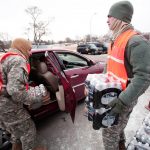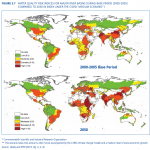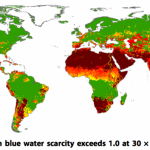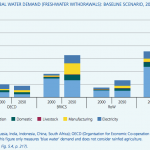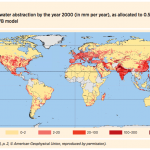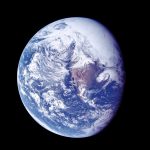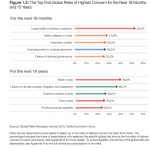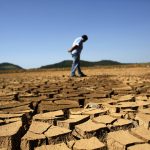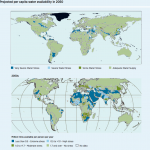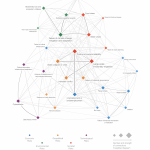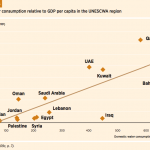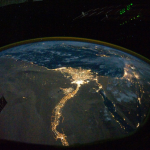Water crises – here’s why


By Gus Lubin From Business Insider
Water crises are the biggest risk in the next 10 years, according to a World Economic Forum survey of experts released in January.
When you look at the big picture, it’s not surprising. In short, we don’t have enough fresh water, and things are getting worse.
Four billion people already face severe water scarcity at least one month each year, according to a recent study. Supply will tighten as populations grow and demand rises for not only drinking water but also use in manufacturing, electricity, and more. At the same time, the world faces rising temperatures and many areas will suffer declining precipitation.
We’ve gathered some worrying insights on what’s coming.
IMAGES:
water crisis drought brazil
REUTERS/Nacho Doce
Four billion people already face water scarcity at least 1 month of the year.
Science Advances
Source: Mekonnen, Mesfin M. and Arjen Y. Hoekstra (2016), “Four billion people facing severe water scarcity” in “Science Advances.”
Things will get a lot worse by 2050. Extreme water scarcity is expected to cover nearly all of the Middle East, large parts of Africa and Asia, and significant parts of the Americas too.
UN World Water Development Report 2012
Source: UN World Water Development Report 2012
.
Global freshwater demand is expected to rise around 50% from 2000 to 2050. Most of that will be for manufacturing and energy.
UN World Water Development Report 2016
Source: UN World Water Development Report 2016
All the while, global warming will aggravate precipitation extremes, with today’s dry areas getting even dryer.
NOAA
Humans are increasingly relying on groundwater, with usage rates tripling over 50 years. Over-use of that supply can cause it to become depleted or contaminated.
UN World Water Development Report 2012
Source: WWDR 2012
Case-in-point, California has relied on groundwater for as much as 60% of its supply in drought years—a number that has alarmed environmentalists.
A field of dead almond trees is seen next to a field of growing almond trees in Coalinga in the Central Valley, California, United States May 6, 2015.Reuters/Lucy Nicholson
Source: Choy, Hanny and Geoff McGhee (2014), “Understanding California’s Groundwater” from Stanford University
Water is already a luxury in some places. GDP per capita and water consumption are clearly linked in the Middle East.
UN World Water Development Report 2012
Source: WWDR 2012
Many countries are dealing with multiple water-related hotspots. Cambodia, for instance, is flood-prone, cyclone-prone, drought-prone, and unusually exposed to climate change, with poor access to drinking water and poor-access to sanitation.
UN World Water Development Report 2012
Source: WWDR 2012
Another major problem is water quality, which is projected to deteriorate significantly due to chemical pollutants. The map below shows how much water quality risk will increase by 2050.
UN World Water Development Report 2016
Source: WWDR 2016
America’s problems with water quality are tied to infrastructure decline. Without more investment, the country faces more incidents like the recent discovery of lead-poisoning in Michigan.
Bill Pugliano/Getty Images
Control of water resources will be a growing source of tension worldwide. For instance, countries may fight for access to five great river systems in the equatorial region known as the Great World Desert.
“Climate Change and Armed Conflict”
Source: Lee, James (2009), “Climate Change and Armed Conflict: Hot and Cold Wars” from Routledge Studies in Peace and Conflict Resolution
Take the Nile: “There appears to be an inevitable collision between Egypt’s need for water, as a downstream user, and rising needs upstream to satisfy growing populations in Sudan and Ethiopia,” writes Professor James Lee in “Climate Change and Armed Conflict.”
Egypt’s dependence on the Nile can be seen from space.NASA via Flickr
Also worrying: eight of the ten longest rivers in Asia originate in China in some way, with six coming from Tibet. “China’s ability to control these waters and use them internally will be a central geopolitical issue,” writes Lee.
Damir Sagolj/Reuters
Source: “Climate Change and Armed Conflict: Hot and Cold Wars”
Tensions could also rise over cloud seeding to generate rain, even though this technique does not actually steal rain from neighboring areas. “Countries have gone to war over less,” Lee said in Esquire.
An agricultural aircraft flies over Nakhonsawan province, in a bid to seed clouds, north of Bangkok, Thailand July 9, 2015.REUTERS/Chaiwat Subprasom
Source: “Mueller, Max” (2016), “How the UAE is making it rain” in “Esquire Middle East”
Put it all together, and it’s no wonder water is the biggest risk in the next 10 years.
World Economic Forum
Source: World Economic Forum
Water crises are, of course, linked to a lot of other crises.
World Economic Forum
Source: World Economic Forum
Our best hope? Reducing water use in manufacturing, energy, and agriculture is key. So is international cooperation to help people around the world and stop new conflict.
For more on this story go to: http://www.businessinsider.com/water-crises-charts-2016-10?utm_source=feedburner&%3Butm_medium=referral&utm_medium=feed&utm_campaign=Feed%3A+businessinsider+%28Business+Insider%29/#four-billion-people-already-face-water-scarcity-at-least-1-month-of-the-year-1

